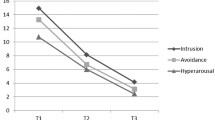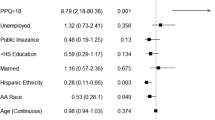Abstract
Purpose
Our objective was to explore if women who experience emergency peripartum hysterectomy (EPH), a type of severe maternal morbidity, are more likely to screen positive for post-traumatic stress disorder (PTSD) compared to women who did not experience EPH.
Methods
Using a retrospective cohort design, women were sampled through online communities. Participants completed online screens for PTSD. Additionally, women provided sociodemographic, obstetric, psychiatric, and psychosocial information. We conducted bivariate and logistic regression analyses, then Monte Carlo simulation and propensity score matching to calculate the risk of screening positive for PTSD after EPH.
Results
74 exposed women (experienced EPH) and 335 non-exposed women (did not experience EPH) completed the survey. EPH survivors were nearly two times more likely to screen positive for PTSD (aOR: 1.90; 95 % CI: 1.57, 2.30), and nearly 2.5 times more likely to screen positive for PTSD at 6 months postpartum compared to women who were not EPH survivors (aOR: 2.46; 95 % CI: 1.92, 3.16).
Conclusion
The association of EPH and PTSD was statistically significant, indicating a need for further research, and the potential need for support services for these women following childbirth.
Similar content being viewed by others
References
Wilson RE, Salihu HM (2007) The paradox of obstetric “near misses”: converting maternal mortality into morbidity. Int J Fertil Womens Med 52(2–3):121–127
Kastner ES, Figueroa R, Garry D, Maulik D (2002) Emergency peripartum hysterectomy: experience at a community teaching hospital. Obstet Gynecol 99(6):971–975
D’Arpe S, Francschetti S, Corosu R, Palaia I, Di Donato V, Perniola G, Muzil L, Benedetti Panici P (2015) Emergency peripartum hysterectomy in a tertiary teaching hospital: a 14-year review. Arch Gynecol Obstet 291(4):841–847
Geller SE, Rosenberg D, Cox S, Brown M, Simonson L, Kilpatrick S (2004) A scoring system identified near-miss maternal morbidity during pregnancy. J Clin Epidemiol 57(7):716–720. doi:10.1016/j.jclinepi.2004.01.003
Bakshi S, Meyer BA (2000) Indications for and outcomes of emergency peripartum hysterectomy. A five-year review. J Reprod Med 45(9):733–737
de la Cruz CZ, Thompson EL, O’Rourke K, Nembhard WN (2015) Cesarean section and the risk of emergency peripartum hysterectomy in high-income countries: a systematic review. Arch Gynecol Obstet 292(6):1201–1215. doi:10.1007/s00404-015-3790-2
Sakse A, Weber T, Nickelsen C, Secher NJ (2007) Peripartum hysterectomy in Denmark 1995–2004. Acta Obstet Gynecol Scand 86(12):1472–1475
Gould DA, Butler-Manuel SA, Turner MJ, Carter PG (1999) Emergency obstetric hysterectomy—an increasing incidence. J Obstet Gynaecol 19(6):580–583. doi:10.1080/01443619963761
Whiteman MK, Kuklina E, Hillis SD, Jamieson DJ, Meikle SF, Posner SF, Marchbanks PA (2006) Incidence and determinants of peripartum hysterectomy. Obstet Gynecol 108(6):1486–1492. doi:10.1097/01.AOG.0000245445.36116.c6
Yoong W, Massiah N, Oluwu A (2006) Obstetric hysterectomy: changing trends over 20 years in a multiethnic high risk population. Arch Gynecol Obstet 274(1):37–40. doi:10.1007/s00404-006-0122-6
Joseph KS, Rouleau J, Kramer MS, Young DC, Liston RM, Baskett TF (2007) Investigation of an increase in postpartum haemorrhage in Canada. BJOG 114(6):751–759. doi:10.1111/j.1471-0528.2007.01316.x
Engelsen IB, Albrechtsen S, Iversen OE (2001) Peripartum hysterectomy-incidence and maternal morbidity. Acta Obstet Gynecol Scand 80(5):409–412
Kayabasoglu F, Guzin K, Aydogdu S, Sezginsoy S, Turkgeldi L, Gunduz G (2008) Emergency peripartum hysterectomy in a tertiary Istanbul hospital. Arch Gynecol Obstet 278(3):251–256. doi:10.1007/s00404-007-0551-x
Eniola OA, Bewley S, Waterstone M, Hooper R, Wolfe CD (2006) Obstetric hysterectomy in a population of South East England. J Obstet Gynaecol 26(2):104–109. doi:10.1080/01443610500443196
Forna F, Miles AM, Jamieson DJ (2004) Emergency peripartum hysterectomy: a comparison of cesarean and postpartum hysterectomy. AJOG 190(5):1440–1444. doi:10.1016/j.ajog.2004.02.021
O’Hara MW, Swain AM (1996) Rates and risk of postpartum depression—a meta-analysis. Int Rev Psychiatr 8(1):37–54
Beck CT (2001) Predictors of postpartum depression: an update. Nurs Res 50(5):275–285
Kumar R, Robson KM (1984) A Prospective-study of emotional disorders in childbearing women. Brit J Psychiat 144:35–47
American Psychiatric Association (2013) Diagnostic and statistical manual of mental disorders, fifth edition (DSM-5), Washington, DC
Gamble J, Creedy D, Moyle W, Webster J, McAllister M, Dickson P (2005) Effectiveness of a counseling intervention after a traumatic childbirth: a randomized controlled trial. Birth 32(1):11–19. doi:10.1111/j.0730-7659.2005.00340.x
Ballard CG, Stanley AK, Brockington IF (1995) Post-traumatic stress disorder (PTSD) after childbirth. Br J Psychiatry 166(4):525–528
Reynolds JL (1997) Post-traumatic stress disorder after childbirth: the phenomenon of traumatic birth. CMAJ 156(6):831–835
Waldenstrom U, Hildingsson I, Rubertsson C, Radestad I (2004) A negative birth experience: prevalence and risk factors in a national sample. Birth 31(1):17–27
Goodman P, Mackey MC, Tavakoli AS (2004) Factors related to childbirth satisfaction. J Adv Nurs 46(2):212–219. doi:10.1111/j.1365-2648.2003.02981.x
Cohen MM, Ansara D, Schei B, Stuckless N, Stewart DE (2004) Posttraumatic stress disorder after pregnancy, labor, and delivery. J Womens Health (Larchmt) 13(3):315–324. doi:10.1089/154099904323016473
Davydow DS, Gifford JM, Desai SV, Needham DM, Bienvenu OJ (2008) Posttraumatic stress disorder in general intensive care unit survivors: a systematic review. Gen Hosp Psychiatry 30(5):421–434. doi:10.1016/j.genhosppsych.2008.05.006
Cox JL, Holden JM, Sagovsky R (1987) Detection of postnatal depression. Development of the 10-item Edinburgh postnatal depression scale. Br J Psychiatry 150:782–786
Eberhard-Gran M, Eskild A, Tambs K, Opjordsmoen S, Samuelsen SO (2001) Review of validation studies of the Edinburgh Postnatal Depression Scale. Acta Psychiatr Scand 104(4):243–249
Cox JL, Chapman G, Murray D, Jones P (1996) Validation of the Edinburgh Postnatal Depression Scale (EPDS) in non-postnatal women. J Affect Disord 39(3):185–189
Foa EB, Riggs DS, Dancu CV, Rothbaum BO (1993) Reliability and validity of a brief instrument for assessing post-traumatic stress disorder. J Trauma Stress 6(4):459–473
Metropolis N, Ulam S (1949) The Monte Carlo method. J Am Stat Assoc 44(247):335–341
Dwass M (1957) Modified randomization tests for nonparametric hypotheses. Ann Math Stat 28:181–187
Rosenbaum PR, Rubin DB (1983) The central role of the propensity score in observational studies for causal effects. Biometrika 70:41–55
Dehejia RH, Wahba S (2002) Propensity score matching methods for nonexperimental causal studies. Rev Econ Statist 84(1):151–161
Smith J, Todd P (2005) Does matching overcome LaLonde’s critique of nonexperimental estimators? J Econometrics 125(1–2):305–353
Edmondson D, Richardson S, Falzon L, Davidson KW, Mills MA, Neria Y (2012) Posttraumatic stress disorder prevalence and risk of recurrence in acute coronary syndrome patients: a meta-analytic review. PLoS One 7(6):e38915. doi:10.1371/journal.pone.0038915
Gander ML, von Kanel R (2006) Myocardial infarction and frequency, outcome, and post-traumatic stress disorder: atherosclerotic mechanisms. Eur J Cardiov Prev R 13(2):165–172
Breslau N, Davis GC, Peterson EL, Schultz LR (2000) A second look at comorbidity in victims of trauma: the PTSD-major depression connection. Biol Psychiat 47(8):66s–67s
Frayne SM, Seaver MR, Loveland S, Christiansen CL, Spiro A, Parker VA, Skinner KM (2004) Burden of medical illness in women with depression and posttraumatic stress disorder. Arch Intern Med 164(12):1306–1312
Oquendo MA, Friend JM, Halberstam B, Brodsky BS, Burke AK, Grunebaum MF, Malone KM, Mann JJ (2003) Association of comorbid posttraumatic stress disorder and major depression with greater risk for suicidal behavior. Am J Psychiat 160(3):580–582
Leppert PC, Legro RS, Kjerulff KH (2007) Hysterectomy and loss of fertility: implications for women’s mental health. J Psychosom Res 63(3):269–274. doi:10.1016/j.jpsychores.2007.03.018
de la Cruz CZ, Coulter ML, O’Rourke K, Alio PA, Daley EM, Mahan CS (2013) Women’s experiences, emotional responses, and perceptions of care after emergency peripartum hysterectomy: a qualitative survey of women from 6 months to 3 years postpartum. Birth 40(4):256–263. doi:10.1111/birt.12070
Bromet E, Sonnega A, Kessler RC (1998) Risk factors for DSM-III-R posttraumatic stress disorder: findings from the National Comorbidity Survey. Am J Epidemiol 147(4):353–361
Nkansah-Amankra S, Dhawain A, Hussey JR, Luchok KJ (2010) Maternal social support and neighborhood income inequality as predictors of low birth weight and preterm birth outcome disparities: analysis of South Carolina Pregnancy Risk Assessment and Monitoring System survey, 2000–2003. Matern Child Health J 14(5):774–785. doi:10.1007/s10995-009-0508-8
Acknowledgments
Many thanks to Jeanne Moore, MSW, who served as the study social worker, and Drs. Charles Mahan, Ellen Daley and P. Amina Alio, who aided in study development.
Author information
Authors and Affiliations
Corresponding author
Ethics declarations
Conflict of interest
The author declares that there is no actual or potential conflict of interest in relation to this article.
Rights and permissions
About this article
Cite this article
de la Cruz, C.Z., Coulter, M., O’Rourke, K. et al. Post-traumatic stress disorder following emergency peripartum hysterectomy. Arch Gynecol Obstet 294, 681–688 (2016). https://doi.org/10.1007/s00404-016-4008-y
Received:
Accepted:
Published:
Issue Date:
DOI: https://doi.org/10.1007/s00404-016-4008-y




